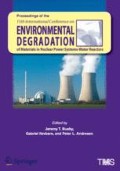Abstract
Materials currently used in nuclear power plants are reliable and are generally resistant to environmental degradation. However, occurrences of environmental degradation have been observed as the current fleet of reactors ages. Primary water stress corrosion cracking (PWSCC) is of particular interest to the US Nuclear Regulatory Commission (NRC). This paper provides a historical assessment of operating experience associated with PWSCC and welding issues associated with PWSCC resistant materials. The paper also considers the regulatory issues associated with PWSCC, especially those associated with gaps in the understanding of the behavior of PWSCC resistant material under actual reactor conditions.
Access this chapter
Tax calculation will be finalised at checkout
Purchases are for personal use only
Preview
Unable to display preview. Download preview PDF.
References
Hunt, E.S. and Gross D.J., PWSCC of Alloy 600 Materials in PWR Primary System Penetrations EPRI TR-103696. July 1994.
Grimmel, B., “U.S. Plant Experience With Alloy 600 Cracking and Boric Acid Corrosion of Light-Water Reactor Pressure Vessel Materials,” NUREG-1823, U.S. Nuclear Regulatory Commission 2005.
Sullivan, E., “Regulatory Perspective on Management of Alloy 82/182/600 Susceptibility and Cracking,” Proceedings of NUPEER 2005.
Materials Reliability Program: Review of Stress Corrosion Cracking of Alloys 182 and 82 in PWR Primary Water Service (MRP-220), Product ID 1015427, Electric Power Research Institute, Palo Alto, CA: 2007.
Materials Reliability Program PWSCC of Alloy 600 Type Materials in Non-Steam Generator Tubing Applications — Survey Report Through June 2002: Part 1: PWSCC in Components Other Than CRDM/CEDM Penetrations (MRP-87), Product ID 1007832, Electric Power Research Institute, Palo Alto, CA 2003.
NEA/CSNI-UNIPEDE, Specialist meeting on Steam Generators Proceedings,” CSNI Report No. 91 Volume 1. 1985.
Generic Letter 97-01, Degradation of Control Rod Drive Mechanism Nozzle and Other Vessel Closure Head Penetrations, Nuclear Regulatory Commission, Washington DC, 1997.
Bulletin 2001-01, Circumferential Cracking of Reactor Pressure Vessel Head Penetration Nozzles, Nuclear Regulatory Commission, Washington DC, 2001.
Bulletin 2002-02, Reactor Pressure Vessel Head and Vessel Head Penetration Nozzle Inspection Programs, Nuclear Regulatory Commission, Washington DC, 2002.
Information Notice 2002–11, Recent Experience with Degradation of Reactor Pressure Vessel Head, Nuclear Regulatory Commission, Washington DC, 2002.
Information Notice 2003–11, Supplement 1, Leakage Found on Bottom-Mounted Instrumentation Nozzles, Nuclear Regulatory Commission, Washington DC, 2003.
Materials Reliability Program: Alloy 82/182 Pipe Butt Weld Safety Assessment for US PWR Plant Designs (MRP-113), Product ID 1009549, Electric Power Research Institute, Palo Alto, CA: 2007 p 2-1.
Bruemmer, S. M., Charlot, L. A., and Henager C. H., “Microstructure and Microdeformation Effects on IGSCC of Alloy 600 Steam Generator Tubing.” Proceedings: 1987 EPRI Workshop on Mechanisms of Primary Water Intergranular Stress Corrosion Cracking. EPRI NP-5987SP.
Materials Reliability Program (MRP), Resistance to Primary Water Stress Corrosion Cracking of Alloys 690, 52, and 152 in Pressurized Water Reactors (MRP-111), Product ID 1009801, Electric Power Research Institute, Palo Alto, CA, 2004.
Collins, M. G., Ramirez, A. J., and Lippold, J. C., An investigation of Ductility-Dip Cracking in Nickel-Based Weld Metals — Part III, Welding Research Supplement to Welding Journal, Feb 2004, p 39s–49s
Young, G. A., et. al., The Mechanism of Ductility Dip Cracking in Nickel-Chromium Alloys, Welding Research Supplement to Welding Journal, Feb 2008, p 31s–43s
Paul, L., and Young, G. A., A New Nickel-Based Weld Filler Metal for Use in Nuclear Power Plant Construction, Corrosion 2011, Paper 11199, NACE International, Houston TX, 2011.
Toloczko, M.B., and Bruemmer S.M., “Crack-Growth Response of Alloy 690 in Simulated PWR Primary Water,” Proc.14th International Conference on Environmental Degradation of Materials in Nuclear Power Systems-Water Reactors, ANS, 2009, p. 706.
Toloczko, M. B., Olszta, M. J., and Bruemmer, S. M., “One Dimensional Cold Rolling Effects on Stress Corrosion Crack Growth in Alloy 690 Tubing and Plate Materials,” Proc.15th International Conference on Environmental Degradation of Materials in Nuclear Power Systems-Water Reactors, ANS, 2011.
Nuclear Regulatory Commission archived documents ADAMS Nos. ML1035004571 and ML003723501.
Pressurized Water Reactor Primary Water Chemistry Guidelines, Rev.5, Product ID 1002884, Electric Power Research Institute, Palo Alto CA, 2003.
Pressurized Water Reactor Secondary Water Chemistry Guidelines, Rev.6, Product ID 1008224, Electric Power Research Institute, Palo Alto CA, 2004.
Author information
Authors and Affiliations
Editor information
Editors and Affiliations
Rights and permissions
Copyright information
© 2011 TMS (The Minerals, Metals & Materials Society)
About this paper
Cite this paper
Alley, D., Dunn, D. (2011). Current NRC Perspectives Concerning Primary Water Stress Corrosion Cracking. In: Busby, J.T., Ilevbare, G., Andresen, P.L. (eds) Proceedings of the 15th International Conference on Environmental Degradation of Materials in Nuclear Power Systems — Water Reactors. Springer, Cham. https://doi.org/10.1007/978-3-319-48760-1_3
Download citation
DOI: https://doi.org/10.1007/978-3-319-48760-1_3
Publisher Name: Springer, Cham
Online ISBN: 978-3-319-48760-1
eBook Packages: Chemistry and Materials ScienceChemistry and Material Science (R0)

